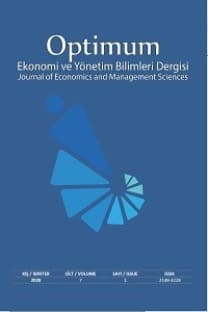SSCI Kapsamındaki Dergilerin Kamu Yönetimi Alanına Katkısı Üzerine Bir Değerlendirme
Atıf dizinleri etkili bir literatür taraması oluşturmak için önemli unsurlar arasında görülmektedir. Özellikle Türkiye’de akademik yükselmelerde SSCI’da yayım yapma koşulu getirildiğinden beri atıf dizininde yayımlanan bilim yazılarının değeri artmıştır. Bu nedenle, dergilerin bibliyometrik değerleri ve konu dağılımları bilhassa ilgili disiplinde çalışan akademisyenler için büyük önem arz etmektedir. Bu çalışmada, SSCI’da yayımlanan Kamu Yönetimi alanındaki dergilerden 2013 JCR’ye göre 5-yıllık etki faktörü en yüksek olan on dergi seçilerek bu dergilerin nicel ve nitel değerleri incelenmiştir. Araştırma sonucunda alana en çok katkısı olan dergiler belirlenerek, seçilen dergilerdeki konu başlıklarının ve konu dağılımlarının ortaya konmasıyla Kamu Yönetimi disiplininde çalışacak olan araştırmacılara fayda sağlanması amaçlanmıştır.
Anahtar Kelimeler:
SSCI, Dergi, Kamu Yönetimi, Atıf dizinleri, Etki Faktörü
An Evaluation on the Contribution of Journals Published by SSCI to the Area of Public Administration
Citation indexes are regarded as important factors to make an effective literature review. Since the publication on the SSCI has been a requirement for the academic degrees in Turkey, the value of scientific articles published in citation indexes has increased. Therefore, bibliometric values and the topic distribution of journals published in a specific discipline are of great importance especially for academicians working in the related discipline. This study will select ten journals that have the highest value of 5-year impact factor in the 2013 JCR among the journals published in Public Administration in SSCI and examine their quantitative and qualitative values. As a result of the research, it is intended to generate benefits for researchers that will work in the discipline of Public Administration through specifying the most contributing journals to the field and presenting subject headings and the distribution of topics in the selected journals.
Keywords:
SSCI, Journals, Public Administration, Citation indexes, Impact Factor.,
___
- Al, u. ve Soydal, İ. (2011). Atıf Dizinlerindeki Türkiye Adresli Dergiler Üzerine Bir Değerlendirme. Bilgi Dünyası, 12 (1), 13-29.
- Asan, A. (2005). SCI-EXPANDED, SSCI, AHCI ve Etki Faktörü ( = Etki Faktörü). O. Yılmaz (Ed.), Sağlık Bilimlerinde Süreli Yayıncılık 3. Ulusal Sempozyum Kitabı (s. 221-263). Ankara: TÜBİTAK ULAKBİM.
- Bearfield, D. A. ve Eller, W. S. (2007). Writing a literature review: the art of scientific literature. G. J. Miller & K. Yang (Eds.), Handbook of research methods for public administration (pp. 61-72). New York: CRC Press, Taylor & Francis.
- Brown, D. J. ve Boulderstone, R. (2008). The Impact of Electronic Publishing: The Future for Publishians and Librarians. Müchen: K.G. Saur.
- Cameron, B. D. (2005). Trends in the usage of ISI bibliometric data: Uses, abuses and implications. Portal: Libraries and the Academy, 5 (1), 105-125.
- Davison, R.M., Jan deVreede, G. & Briggs, R. O. (2005). On peer review standards for the information systems literature. Communications of the Association for Information Systems, 16 (4), 967-980.
- Falagas, M. E., Kouranos, V. D., Arencibia-Jorge, R. & Karageorgopoulos, D. E. (2008). Comparison of SCImago journal rank indicator with journal impact factor. The Federation of American Societies for Experimental Biology Journal, 22 (8), 2623-2628.
- Fooladi , M., Salehi, H., Yunus, M. M., Farhadi, M., Chadegani, A. A., Farhadi, H. & Ebrahim, N. A. (2013). Does Criticisms Overcome the Praises of Journal Impact Factor?. Canadian Center of Science and Education, 9 (5), 176-182.
- Garfield, E. (1972). Citation analysis as a tool in journal evaluation. Science, 178, 471-479.
- Garfield, E. (1994). The impact factor: ISI. Current Contents, 25, 3-7.
- Grabosky, P. N. ve Wilson, P. R. (1989). Journalism and Justice: How Crime is Reported. Leichhardt, N.S.W. : Pluto Press.
- Gulick, L. H. ve Urwick, L. F. (1937). Papers on the Science of Administration. New York: Institute of Public Administration, Columbia University.
- Hendry, C. ve Farley, A. (1998). Reviewing the literature: a guide for students. Nurs Stand, 12 (44), 46-48.
- Justice, J. B. (2007). Purpose and significance of research design. G. J. Miller ve K. Yang (Eds.), Handbook of research methods for public administration (pp. 75-92). New York: CRC Press, Taylor & Francis.
- Khan, K. M. ve Hegde, P. (2009). Is impact factor true evaluation for ranking quality measure?. Journal of Library & Information Technology, 29 (3), 55-58.
- Klein, D. B. ve Chiang, E. (2004). The Social Science Citation Index: A Black Box—with an Ideological Bias?. Econ Journal Watch, 1 (1), 134-165.
- McCulloch, F. (1995). The real competition: Old-fashioned newspapers. Nieman Reports, 49 (2), 56.
- Pritchard, A. (1969). Statistical bibliography or bibliometrics?. Journal of Documentation, 24, 348-349.
- Rousseau, R. (1988). Citation distribution of pure mathematics journals. L. Egghe ve R. Rousseau (Eds.), Informetrics 87/88: Select proceedings of the first international conference on bibliometrics and theoretical aspects of information retrieval (pp. 249-262). Amsterdam: Elsevier.
- Tamilselvan, N., & Balasubramanian, S. (2012), “Journal Impact Factor (JIF) in Digital Era”, International Journal of Library and Information Science, Vol. 1, No: 1, s. 1-14.
- Testa, J. (2006). The Thomson Scientific journal selection process. International Microbiology, 9, 135-138.
- Testa, J. (2011). The Thomson Reuters Journal Selection Process. [Çevrim-içi: http://wokinfo.com], Erişim tarihi: 13.10.2014.
- Timmins, F. - McCabe, C. (2005). How to conduct an effective literature review. Nurs Stand, 20 (11), 41–7.
- Yaltırak, C. (2014). Uluslararası Bilimsel Yayın Destekleme Sınıflamasının Akademik Yükseltme ve Atamalarda Kullanılmasının Yarattığı Sorunlar. [Çevrim-içi: http://www.researchgate.net], Erişim tarihi: 18.11.2014.
- Yayın Aralığı: Yılda 2 Sayı
- Başlangıç: 2014
- Yayıncı: -
Sayıdaki Diğer Makaleler
Dış Ticaret Hadleri Ekonomik Büyüme İlişkisi: Türkiye Üzerine Bir Uygulama
Ramazan EKİNCİ, Osman TÜZÜN, Hakan KAHYAOĞLU
TR33 Bölgesi Devlet Hastanelerinin Performanslarının Bulanık AHP Yöntemi İle Ölçümü
Türk Cumhuriyetlerinin Bilgi Ekonomisi Analizi
Türkiye’nin Turizm Arzı, Piyasa Yapısı ve Global Riskler: Keşifsel Bir Yaklaşım
Elektrik Piyasalarında Yeniden Yapılanma ve Türkiye Elektrik Piyasasında Yapısal Dönüşüm
Türkiye’de Kamu Hizmetlerinin Toplumsal Denetimi: Kent Konseyi Örneği
Ahmet ÖZEN, Ercan BAHTİYAR, Mahmut ŞAŞMAZ
SSCI Kapsamındaki Dergilerin Kamu Yönetimi Alanına Katkısı Üzerine Bir Değerlendirme
